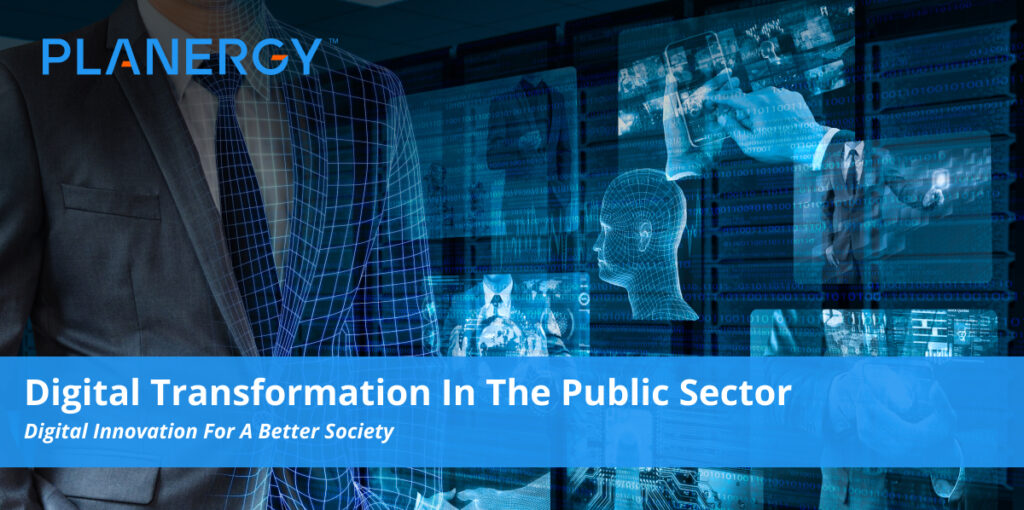Digital transformation is often discussed as an important strategic tool for businesses looking to compete, innovate, and grow in today’s marketplace.
But as more and more companies in the private sector embrace digital technologies, redefining customer experiences and generating a major impact on the expectations people have for immediately accessible information, a la carte service delivery, and unlimited customization, public sector organizations struggle to keep up.
That said, digital transformation in the public sector is achievable.
If government organizations are willing to build a strong digital strategy and digital infrastructure that will support new technologies and high-quality digital services, they’ll be well-prepared to tackle digital transformation projects.
Challenges to Effective Public Sector Digital Transformation
Professionals managing the digital transformation journey for government agencies face the same challenges as their private sector counterparts, including:
- Using needs analysis to create and implement an effective roadmap for the digital journey that meets budgetary, compliance, and industry requirements.
- Obtaining total buy-in from management, staff, and vendors.
- Educating and training team members in the tools, practices, and workflows that accompany digital transformation.
- Finding ways to implement technological hallmarks of digital disruption such as big data analytics and management, process automation, artificial intelligence, the Internet of Things (IoT) and the blockchain in ways that minimize interruption to existing work while simultaneously introducing gains in productivity, efficiency, and profitability.
Unlike their private sector analogues, however, public sector teams also face a few additional challenges that create a much rockier road leading to a successful digital transformation journey.
Consider these additional headaches that accompany public sector digital transformation:
A Larger, More Diverse Customer and Stakeholder Base.
The sometimes labyrinthine interdependencies of government departments can create serious red tape as an obstacle to any project, let alone one as ambitious and complex as digital transformation.
Add in the potential for political shake-ups and their subsequent restructurings, ownership of resources spread (and sometimes scattered!) across different government departments and agencies, and sometimes mutually-unintelligible information management schema, and you’ve got a recipe for frustration.
The more stakeholders, the more difficult it is to achieve buy-in.
And when your “customers”—in this case, the public as a whole—are also stakeholders with civil and legal rights to weigh in with a dazzlingly diverse array of expectations and opinions regarding what’s to be done, how to do it, and whether it’ll ever be paid for, you need powerful tools, clean processes, and as much information as possible to make progress.
Tighter Budgets and Public Accountability
With public eyes on every dollar spent, governments have a strong incentive to make sure they get an optimal return on investment.
But as in private enterprise, the option that generates the greatest immediate cost savings may not turn out to be the best choice for lasting value.
In addition, government agencies often have smaller budgets to work with than corporate professionals.
Obtaining more funds is often an exercise in frustration as well, since the same red tape that makes starting a project so challenging can be even more formidable when the issue of additional taxpayer funds comes into play.
Antiquated Infrastructure
While plenty of private corporations and organizations are positively primeval with regard to the digital transformation journey, governments are by their very nature even slower to change without serious, concerted, and sustained effort.
Just as funds seem to take forever to trickle toward maintenance of pitted roadways or replacement of aged trains and buses, the technological infrastructure of a town, state, province, county, or country may also be stuck decades, or even centuries, in the past.
The slow grind of government wheels can make it harder to deliver services such as on-demand forms, online registration and bill paying, and automated tech support to a populace long accustomed to enjoying such capabilities when interacting with private businesses.
In fact, the World Economic Forum reported in 2015 that an estimated $100 trillion U.S. in digital infrastructure improvements will be required between now and 2025 to keep up with public expectations and demand for services.
Despite these additional challenges, the incentive to embrace digital disruption as a virtue remains strong; in a world where governments can spend trillions in a single year, supplying the digital services the public expects and demands is not just good business—it’s an opportunity to strengthen the financial health, efficiency, and future readiness of local, city, state, and national governments.
Beyond the savings and efficiency gains created, digital transformation creates important quality of life improvements for a wide array of citizens. Less paper means less waste and expense; digital, 24/7 access ensures essential services are available even during nontraditional hours; and special populations, such as rural residents and those living with chronic conditions, can still access essential services without undue hardship.
Achieving Public Sector Digital Transformation
Difficulties aside, governments are taking steps to address citizen expectations and demand for digital services. In Estonia, for example, a full 99% of government services can be accessed online.
Citizens can use their electronic ID to do everything, including managing their healthcare information, attending online classes, paying taxes, and even voting in local, regional, and national elections.
A similar site in the United Kingdom (where Deloitte found that 96% of respondents working in the public sector saw digital transformation as having a major impact on their respective domains), gov.uk, provides that country’s citizens with a central hub for managing just about any task related to the government.
And in 2018, Denmark leapt to the front of the class in the European Union’s E-Government survey, which measures the effectiveness and utility of digital services provided by governments to their citizenry.
The Danes have made no secret of pursuing a digital-first strategy, and as a result, 91% of Danish people now receive government communications via email instead of physical post, and those with a NemID (a government digital ID) can do everything from paying their taxes to choosing a phone plan to making an appointment at the hair salon.
It’s not pure convenience or improved user experience driving these changes, of course. Beyond the savings and efficiency gains created, digital transformation creates important quality of life improvements for a wide array of citizens.
Less paper means less waste and expense; digital, 24/7 access ensures essential services are available even during nontraditional hours; and special populations, such as rural residents and those living with chronic conditions, can still access essential services without undue hardship.
In addition, digital transformation is essential to the creation of “smart cities” that will build on today’s digital services with even greater convenience, data completeness and transparency, and quality of life improvements.
For example, Helsinki has a region known as the “Smart Kalasatama District” where new tech and expanded digital services are live-tested by the people themselves.
Residents charge their cars on the public grid, waste systems track fullness to reduce collection traffic, and smart energy grids control the flow and ebb of power to ensure optimal usage with minimal waste.
While generating savings, building smart cities, and empowering the citizenry are noble goals, the challenges that government organizations must overcome when implementing digital transformation remain.
And to overcome them, the public sector organizations would do well to focus their planning and technological efforts on digitizing perhaps the most important source of potential value and true transformation: procurement.
Because it rests at the very center of an organization’s infrastructure (digital or otherwise) and touches every business unit, the procure-to-pay (P2P) process is a sometimes overlooked but nevertheless inspired place to start the digital journey.
Every dollar spent represents not just goods and services purchased, but a vast web of interactions that provide a wealth of data with the potential to help improve workflow efficiency, lower overhead, and increase the convenience and utility of government services for the people who matter most: the citizens.
Digitizing procure-to-pay is a fast and effective way to begin implementing digital transformation within any organization.
It is customizable enough to provide wary government agencies with a way to dip their toes in the digital waters, and powerful enough to provide a firm foundation for organization-wide changes such as process automation, integration and organization of disparate (and formerly siloed) data sources to shared, cloud-based data servers, and connection of IoT devices to support advanced data analytics and expanded services to the public.
Choosing comprehensive purchasing software such as PLANERGY enables:
- Complete transactional transparency. All data related to any transaction is recorded, organized, and stored for real-time retrieval and analysis, protected by leveled access. Teams can do more with small budgets by analyzing this data to optimize workflows, reduce supply chain bloat, and ensure optimal terms and conditions from preferred suppliers.
- Process automation, supported by artificial intelligence, providing greater accuracy, speed, and efficiency for low-level, high-volume, time-consuming tasks. It also eliminates waste from paper-based document creation and storage, and frees staff to provide more important services to the public.
- Deep data analytics, which make it possible to begin streamlining the supply chain, generating immediate savings while strengthening supplier relationships and opening the door to collaborative initiatives between public and private enterprise.
- Easy integration with existing software environments. This makes it much simpler to connect and collaborate between departments and agencies, lowering barriers to change, improving implementation times, and providing a model for public-facing workflows to enable fully digital access to, for example, bill paying, tax services, land and property registration, and voting.
- Improved security of spend. Eliminating rogue spend and invoice fraud helps protect public funds, while automation and centralized data storage easily integrate with advanced cybersecurity and encryption tools such as blockchain to ensure every transaction is accurate, well documented, and audit-ready.
Today’s Digital Transformation Will Power the Society of Tomorrow
For the public sector, digital transformation presents a special challenge that is nonetheless worth the time and effort required, as it pays rich dividends via cost savings, process improvements, and quality of life improvements for the citizens who depend on government agencies.
By investing first in P2P digitization, government organizations can create a firm foundation for digital transformation in all areas, and begin the process of providing digital services to the citizenry, as well as set the stage for advanced technological transformation.
In taking these crucial first steps, today’s governments will ensure those living in the smart cities of tomorrow enjoy better services, greater security, and a higher quality of life.




